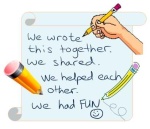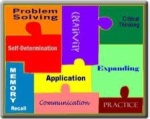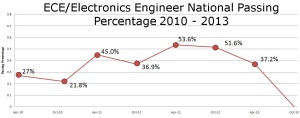Why change assessment practices?
Assessment in the traditional teaching practice is mainly concerned about assigning numbers or letters to represent what a student has learned over the term. It does not in any way aim to modify instuctions or curriculum to better improve students’ learning. In today’s age and time, assessment has found a new meaning, in that it aims for high quality learning for all by redesigning instructions to further enhance students’ learning.
|
What I already knew |
What I hadn’t thought of before |
|
I already knew that assessment is giving grades by assigning numbers or letters to represent what a student has learned over the term/ quarter/school year. I knew that these grades sum up the students’ achievements and either celebrates or condemns the students’ effort or non-effort in his studies. |
I never knew that assessment could be an effective way to improve student learning. Since my misconceptions on assessment is that it is only summative in intent, then it can not correct past errors either by the student or by the teacher. What a student has failed to learn,can only be charged to experience. |
Assessment and Learning; Using Assessment to Differentiate Learning
Your Jojo Story
There are several notions which I thought of to be the basic truth, but due to the immense and easily accessible information on the internet, I became aware that my notions are wrong. One classic example is the belief that all children diagnosed with ADHD are hyperactive children. This could be because my schema came from viewing several media documentaries featuring only the hyperactive side of the disorder. From reading diverse materials on the internet regarding this attention disorder, I know better now that even hypoactive children may be diagnosed with the syndrome.
|
What I already knew |
What I hadn’t thought of before |
|
As previously stated, I already knew then that the purpose of assessment is to sum up or recognize the efforts of students in their studies, to either promote them to the next grade level or have them repeat the current grade level due to inability to acquire the minimum learning required to pass. |
…is that assessment could serve two other purposes, more significant purposes in fact, to further one’s learning. From what I have gained from Earl & Katz’s Rethinking Classroom Assessment with Purpose in Mind, and from Dr. Lorna Earl’s video presentation, assessment, in order to promote high quality education for all should focus more on the purposes FOR and AS learning more than OF learning.. |
Following the Webcast
Where do you see yourself on the continuum in relation to using assessment for different purposes and adapting your practices to the purpose that they are intended to serve? Do you have some experience? Are you starting to see the many questions that still need to be asked? Do you feel like your assessment practices are differentiated and appropriate to the intended purpose?
I am still on the emergent side of the continuum, being just aware of the other purposes of assessment. I have absolutely no experience in planning assessments for and as learning, though I believe that I have done formative assessment unintentionally, giving feedbacks to students with whom I have seen some misconceptions in learning. I have yet to formally plan and incorporate these purposes in designing my instructions, but I fully agree that I should make these changes soon because without doing so would beat my very purpose of developing my students’ potential to the maximum.
Teachers’ Roles in Classroom Assessment
Consider the three tables below and enter examples of how you do this already or could do it in the future
|
ASSESSMENT FOR LEARNING |
Examples |
|
How do (or could) I: 1)Design and use assessments to determine what students are thinking in relation to the expectations, in order to streamline and target instruction and resources. 2)Create assessments that provide detailed information about the progression of learning in key areas of the curriculum 3)Target teaching strategies to the student needs that emerge from regular assessments 4)Provide timely descriptive feedback and direction 5)Select and/or adapt materials and resources for focused instruction with a student or group of students |
1)I could use various methods of assessing students at the start of the schoolyear so that I would have a basis in forming a mental image of what my students have perceived to be true. 2)I would assess my students’ learnings as often as every Friday with a short quiz so that before the next week begins, I would have formed a mental image of what my students have and have not learned. 3)I shall group my students based on their perceived understanding of the previous lesson, so I can focus more on those students who are behind, by either giving them more examples for me to elaborate the concept or by using much simpler explanation using lay language. 4)I would put brief but concise “love letters” on my students work, pointing out where they started going wrong in their approach to problem solving, and encourage them to try doing it again, this time using the hints that I gave them. 5)I would deviate temporarily from the traditional blackboard discussion and I would employ interactive, kinesthetic ways (which I would constantly be on the look out for) of explaining the concept and would find ways to incorporate my lesson in everyday life so that students will see the practicality of learning the topic. |
|
ASSESSMENT AS LEARNING |
|
|
How do (or could) I: 1)Construct and use assessments to allow students to think about and monitor their own learning and develop internal feedback or self-monitoring mechanisms to validate and to question their own judgments
2)Provide students with rubrics and exemplars as models of good practice
3)Teach students to reflect on their learning, identify different possibilities, challenge their ideas for inaccuracies, and work toward better understanding
4)Provide opportunities for practice, independence, and responsibility
5)Monitor students’ metacognitive processes as well as their learning |
1)At the start of the class, I would openly inform my students, orally and in writing, my expected learning outcomes at the end of the term. This is so that any ambiguity about the expected curriculum outcomes is ironed out and students would know that they can also expect me to be transparent with my assessment at the end of the term. I would also generously praise students who exert good efforts in my subject so that others may be influenced by their success and will try to emulate if not exceed their achievements. 2) In correcting erroneous math solutions (yes, they must be corrected for better grasping of the concept), I would train my students to identify the focal point wherein they committed mistakes, and work from there in solving the problem again. It would make the students aware of what they did wrong on their own, and then this realization will be embedded in their long term memory since it involved deep thoughts. 3)I would explain to students that of the many weekly quizzes, I would only use perhaps four or five of the highest scores they got, in computing for their quarterly grade. I would further explain that this is done so that those who got low scores may not get demoralized but rather encouraged to do better next time in order to make up for the low scores. 4) I would assess students’ metacognitive process by giving them questionnaires on how they did their work (projects, portfolio, etc) and encourage them to answer as honestly as they can since these answers would in no way affect their grades. Students would be confronted with the thruth, whether they exerted much, enough or little effort in their work. Without the need of my praising or condemning them, students will realize the results of their actions and would lead to self-regulation in order to be happier with their own selves in the future. |
Working Together for Purposeful Assessment
How has this webcast changed your level of understanding about the purposes of classroom assessment?
This webcast, along with the article of Earl & Katz’s Rethinking Classroom Assessment with Purpose in Mind (2006), made me ,first, aware of the different purposes of assessment, second, what purposes are better prioritized than the others, and third, how these purposes should be aligned with my instructional approach. It also opened my eye on the impact of assessment on students’ learning and the ultimate goal of maximizing their potentials.
How has this webcast changed how you view your existing assessment practices? (e.g., Do you see ways you could ensure that your assessment is consistent with balancing the purposes? Do you think your students could benefit from new assessment practices in the classroom?)
This webcast, and the mentioned article, has changed my view of my own assessment practices in that I will now revisit my curriculum objectives, check whether the desired learning outcomes are aligned with my teaching strategies, then plan assessments according to specific purposes of “for, as and of learning”. Effective planning and execution of assessment with specific purposes in mind will help me understand my students’ learning, redesign my instructions, guide them towards improved learning habits and give them the most accurate and fair grade they deserve at the end of the term. Yes, they will most definitely benefit from all of these plans.
Do you feel ready to try making changes in your practices?
I may not have the experience and full know-how right now, but I am willing to give my best effort in implementing these changes in my teaching practice and make sure it is a success. Much as I expect my students to exert their best efforts in class, I too, must learn as much as I can to transcend from emergent to proficient in my level of experience with using assessment practices.
Do you feel the need for more support? If you need more support, who might provide it? Other colleagues? Your principal?
My colleagues and my superiors could provide the support I need in implementing such changes. I should be able to convince them of the benefits of these changes and the impact these would have in transforming education into one which aims at students’ achievements and ensuring a better future for them.
Looking to the Future
What are the three most significant things you can do to improve your classroom assessment practices?
1. I should check the validity and reliability of my assessments. They should make my students’ learnings and misconceptions visible.
2. I should redesign my instructions in order to have a differentiated one which would enable me to focus more on my students’needs.
3. I should make sure to give timely and descriptive feedback to my students to
enhance their self-regulation skills and further their learning.
What can I do to improve my classroom assessment practice? What do I need in order to do this?
I need to revisit my assessment practices, and confer with other teachers to correlate my findings with their assessments of the same students.
I should explore much on how to effectively alter my instructions to cater to my students’ needs.
I need to monitor each of my students’ progress and keep an accurate record of my observations in order to give effective feedbacks.
Where can I get what I need? Whose help do I need to engage?
I will need other teachers’ mental images of my students and see if they correlate with my own.
I can explore on the internet or I could ask suggestions from other teachers employing assessments with specific purposes in mind.
I can engage the help of my students’ parents in helping their children practice metacognition and self-regulation particularly at home.
How will I know that I improved? (i.e. What will I see?)
If in my next assessments, my students’ misconceptions have been corrected and they have a clear grasp of the current topic, which would not have been possible if they carried their misconceptions to this topic.
If I were able to get my students to fully understand the concept of current topic and erase any previous misconceptions they may have had.
If my students can fully employ self-marking and self-learning with minimal guidance.
This act will not put me in the hate list of my students and will encourage them to participate as cooperatively aspossible in all my assessments.








